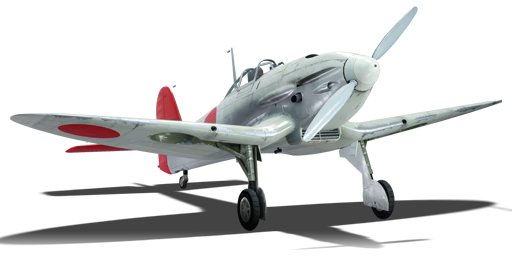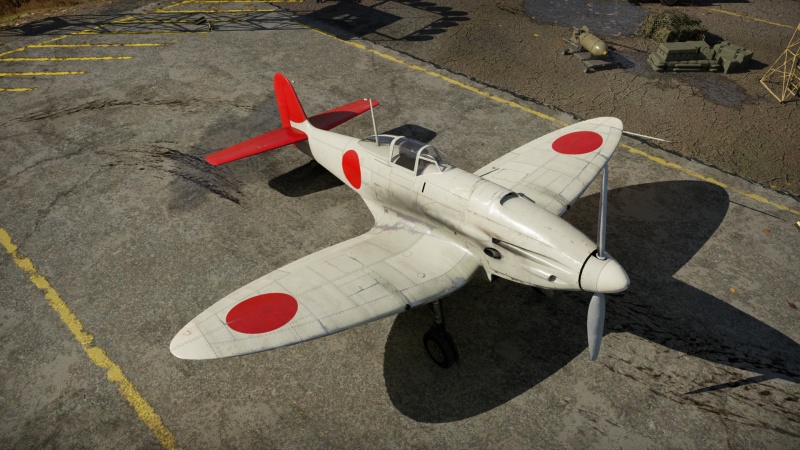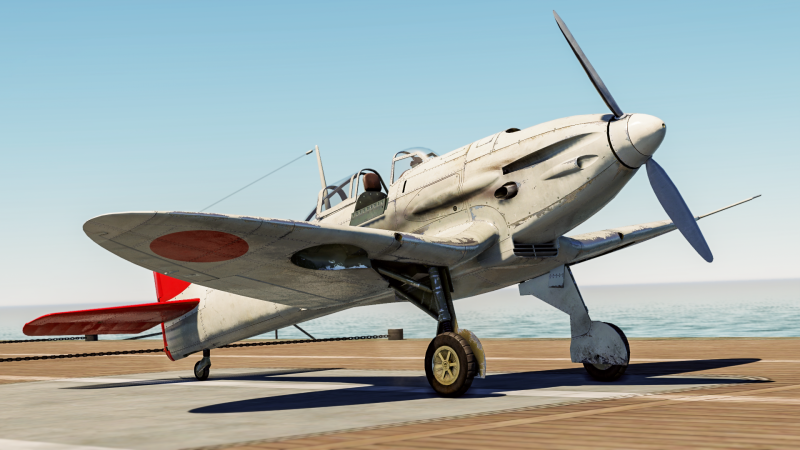Difference between revisions of "A7He1"
Colok76286 (talk | contribs) (Edits) |
m (→Description) |
||
| Line 6: | Line 6: | ||
== Description == | == Description == | ||
<!-- ''In the description, the first part should be about the history of and the creation and combat usage of the aircraft, as well as its key features. In the second part, tell the reader about the aircraft in the game. Insert a screenshot of the vehicle, so that if the novice player does not remember the vehicle by name, he will immediately understand what kind of vehicle the article is talking about.'' --> | <!-- ''In the description, the first part should be about the history of and the creation and combat usage of the aircraft, as well as its key features. In the second part, tell the reader about the aircraft in the game. Insert a screenshot of the vehicle, so that if the novice player does not remember the vehicle by name, he will immediately understand what kind of vehicle the article is talking about.'' --> | ||
| − | The '''{{Specs|name}}''' | + | The '''{{Specs|name}}''' was the Japanese Navy's purchase of the German [[He 112 (Family)|He 112 B-0]] to strengthen the {{Annotation|IJNAS|Imperial Japanese Navy Air Service}} in China. The Germans had stopped using the He 112 for their own purposes after it lost to the [[Bf 109 (Family)|Bf 109]] and sold them to other countries. The Japanese tested the A7He1 against their own [[A5M4|A5M]] fighter, which was the best they had at the time. The [[A6M]], a more advanced fighter, was not ready yet. The A7He1 had more powerful guns and could fly faster than the A5M4, but it was not very agile and could not climb as well. It also did not fit the Navy's flying doctrine. The Japanese decided to cancel the order for more A7He1s and only kept them for studying their features, engine and equipment. |
| + | |||
| + | It was introduced in [[Update 1.37]]. It provides an interesting yet different playstyle to the Japanese tree. The name of the game is speed and firepower for the A7He1 / [[He 112 B-0]]. It can reach a maximum speed of 690 km/h, which is very fast for its rank. However, it does not have a stellar climb rate, and it is not very agile or responsive. The best feature of this plane is its armament, which consists of two 20 mm cannons and two 7.92 mm machine guns. | ||
== General info == | == General info == | ||
Revision as of 12:03, 30 June 2023
Contents
Description
The A7He1 was the Japanese Navy's purchase of the German He 112 B-0 to strengthen the IJNAS in China. The Germans had stopped using the He 112 for their own purposes after it lost to the Bf 109 and sold them to other countries. The Japanese tested the A7He1 against their own A5M fighter, which was the best they had at the time. The A6M, a more advanced fighter, was not ready yet. The A7He1 had more powerful guns and could fly faster than the A5M4, but it was not very agile and could not climb as well. It also did not fit the Navy's flying doctrine. The Japanese decided to cancel the order for more A7He1s and only kept them for studying their features, engine and equipment.
It was introduced in Update 1.37. It provides an interesting yet different playstyle to the Japanese tree. The name of the game is speed and firepower for the A7He1 / He 112 B-0. It can reach a maximum speed of 690 km/h, which is very fast for its rank. However, it does not have a stellar climb rate, and it is not very agile or responsive. The best feature of this plane is its armament, which consists of two 20 mm cannons and two 7.92 mm machine guns.
General info
Flight performance
| Characteristics | Max Speed (km/h at 2,800 m) |
Max altitude (metres) |
Turn time (seconds) |
Rate of climb (metres/second) |
Take-off run (metres) | |||
|---|---|---|---|---|---|---|---|---|
| AB | RB | AB | RB | AB | RB | |||
| Stock | 482 | 466 | 8000 | 20.0 | 20.8 | 11.0 | 11.0 | 250 |
| Upgraded | 525 | 502 | 18.0 | 19.0 | 17.3 | 13.8 | ||
Details
| Features | ||||
|---|---|---|---|---|
| Combat flaps | Take-off flaps | Landing flaps | Air brakes | Arrestor gear |
| ✓ | ✓ | ✓ | X | X |
| Limits | ||||||
|---|---|---|---|---|---|---|
| Wings (km/h) | Gear (km/h) | Flaps (km/h) | Max Static G | |||
| Combat | Take-off | Landing | + | - | ||
| 730 | 450 | 498 | 469 | 320 | ~14 | ~14 |
| Optimal velocities (km/h) | |||
|---|---|---|---|
| Ailerons | Rudder | Elevators | Radiator |
| < 280 | < 320 | < 360 | > 315 |
Survivability and armour
The A7He1 has no armour protection, but the fuel tanks are self-sealing. All the major modules are located in the nose and wing roots of the plane. This means the pilot and major modules have very little protection, although from the front the engine can absorb shots before they injure the pilot.
- No armour protection
- Self-sealing fuel tanks
Modifications and economy
Armaments
Offensive armament
The A7He1 is armed with:
- 2 x 20 mm MG FF cannons, wing-mounted (60 rpg = 120 total)
- 2 x 7.92 mm MG 17 machine guns, nose-mounted (500 rpg = 1,000 total)
Usage in battles
The offensive weapons are equal to the Bf 109 E-3 with one exception: the nose-mounted machine guns have half the ammo. While this seems to be a drawback for the He 112/A7He1, it really is not. With 500 rounds per gun, the Heinkel will not run out of ammo any time soon.
The 7.92 mm MG 17s major advantage comes in handy for adjusting shots at long range. The 7.92 mm bullet has better bullet ballistics than the 20 mm MG FF, but they can still be used for predicting the bullet drop of the 20 mm cannon shells. Keep in mind that the MG 17's successor, the 13 mm MG 131, has the same ballistics as the MG 17; a decision deliberately made in real life to allow pilots to immediately use the new MG without having to adjust for a change bullet behaviour.
On paper, the A7He1 appears to be quite well armed, having two machine guns and two MG FF cannons. However, the cannons are quite underwhelming, especially with the Air targets belt. Many of the belts' rounds seem to explode on the surface of enemy aircraft, damaging external features such as control surfaces, but doing very little internal damage. Sometimes, multiple hits can be placed on an aircraft with little or no effect. It is recommended to aim for control surfaces, particularly ailerons and elevators on the wings and tail. This means that if an aircraft can't be knocked out of the sky via firepower, it can be forced to crash due to loss of control.
The A7He1 can perform well in naval battles, especially Naval RB. Compared to other early German and Japanese aircraft which only have poor-penetrating 7.92/7.7mm machine guns, the A7He1 has two powerful cannons which can deal a lot of damage, especially to small boats. It is recommended to use stealth belt in this role, as this belt has lots of APHE rounds.
Manual Engine Control
| MEC elements | ||||||
|---|---|---|---|---|---|---|
| Mixer | Pitch | Radiator | Supercharger | Turbocharger | ||
| Oil | Water | Type | ||||
| Controllable | Controllable Not auto controlled |
Controllable Not auto controlled |
Controllable Not auto controlled |
Separate | Not controllable 2 gears |
Not controllable |
Pros and cons
Pros:
- Good firepower
- Good speed
- Good stability
- Small size
- Plenty of machine gun ammo, decent back-up after cannon ammunition runs out
- Quite manoeuvrable
- Decent roll rate
- Has WEP unlike previous He 112s
Cons:
- Mediocre sustained turn rate
- Low cannon ammunition count
- MG FF cannons' damage can be inconsistent
- No armour or protection around important modules
- Armament can be ineffective in ground attack
- Armament can be ineffective against large bombers
- Poor handling at high speeds
History
As the He 112 was being phased out of German service in favour of the Bf 109, the Germans started considering exporting the design. The first nation placing an order was Japan, who ordered 30 He 112 B-0 to be used on the Chinese front by the Navy. The Japanese Naval designation for the He 112 B-0 was A7He1 (A7 Heinkel 1), as the A6M Zero was still in tweaking stage.
As the first 12 He 112 B-0 arrived, the Navy started comparing their new purchase with some of their own designs. The main comparison was the A7He1 vs A5M. From test results, they concluded that the A7He1 was quite the speed demon compared to the A5M but lacked manoeuvrability and climbing speed. Due this, the Navy scrapped the plan for frontline usage of the A7He1 and used them instead for training and teaching purposes. The planes were also studied to research the wing design, engine, landing gear and auxiliary technology. In addition, a single A7He1 was passed down to the Second Faculty of Engineering, Tokyo Imperial University for further research.
The remaining order of He 112 B-0 was cancelled due to delays and the design being considered inferior to domestic Japanese plane design as well as being too deviant from the IJN's fighter doctrine. The He 112 B-0s of the order remaining in Germany were diverted to the Condor Legion to fight in the Spanish Civil War instead.
Media
- Skins
See also
External links
| Heinkel Aircraft Company (Heinkel Flugzeugwerke) | |
|---|---|
| Fighters | He 51 A-1 · He 51 B-1 · He 51 B-2/H · He 51 C-1 · He 51 C-1/L |
| He 100 D-1 | |
| He 112 A-0 · He 112 B-0 · He 112 V-5 | |
| Jet fighters | He 162 A-1 · He 162 A-2 |
| Twin-engine fighters | He 219 A-7 |
| Bombers | He 111 H-3 · He 111 H-6 · He 111 H-16 |
| He 115 C-1 | |
| He 177 A-5 | |
| Export | He 112 B-1/U2(Hungary) · He 112 B-1/U2(Romania) · He 112 B-2/U2 · A7He1 |
| T 2 | |
| Japan fighters | |
|---|---|
| Navy | |
| Carrier-based fighter | |
| A5M | A5M4 · Hagiri's A5M4 |
| A6M | A6M2 mod. 11 · A6M2 · A6M3 · A6M3 mod. 22 · A6M3 mod. 22Ko · A6M5 · A6M5 Ko · A6M5 otsu · A6M5 Hei · A6M6c |
| A7He | A7He1* |
| A7M | A7M1 (NK9H) · A7M2 |
| Land-based Fighter | |
| J2M | J2M2 · J2M3 · J2M4 Kai · J2M5 · J2M5 (30 mm) |
| J6K | J6K1 |
| J7W | J7W1 |
| N1K-J | N1K1-Ja · N1K2-J · N1K2-Ja |
| Fighter seaplane | |
| N1K | N1K1 |
| A6M-N | A6M2-N |
| Army | |
| Ki-10 | Ki-10-I · Ki-10-I C · Ki-10-II · Ki-10-II C |
| Ki-27 | Ki-27 otsu · Ki-27 otsu Tachiarai |
| Ki-43 | Ki-43-I · Ki-43-II · Ki-43-III otsu |
| Ki-44 | Ki-44-I · Ki-44-I 34 · Ki-44-II otsu · Ki-44-II hei |
| Ki-61 | Ki-61-I ko · Ki-61-I otsu · Ki-61-I hei · Tada's Ki-61-I hei · Ki-61-I tei · Ki-61-II Otsu Kai |
| Ki-84 | Ki-84 ko · Ki-84 otsu · Ki-84 hei |
| Ki-87 | Ki-87 |
| Ki-94 | Ki-94-II |
| Ki-100 | Ki-100 · Ki-100-II |
| Other countries | ▅F4U-1A · ▅P-51C-11-NT · ▅Bf 109 E-7 · ▅Fw 190 A-5 |
| *Imported designation of the He 112 (A6M was in development - A7M would take A7 designation after the cancelation of the A7He) | |
| Japan premium aircraft | |
|---|---|
| Fighters | Hagiri's A5M4 · A7He1 · Ki-27 otsu Tachiarai |
| Ki-44-II otsu · ▅Bf 109 E-7 · ▅F4U-1A · Ki-100-II · Ki-44-I 34 | |
| ▅Fw 190 A-5 · A7M1 (NK9H) · Tada's Ki-61-I hei · ▅P-51C-11-NT | |
| J2M4 Kai · A6M5 Ko · A6M6c · J2M5 · Ki-87 · J6K1 | |
| Twin-engine fighters | Ki-96 |
| Jet fighters | F-86F-40 JASDF▅ · T-2 Early · F-4EJ ADTW |
| Bombers | Ki-21-I hei · Ki-48-II otsu · H8K3 · B7A2 (Homare 23) · ▅B-17E |






